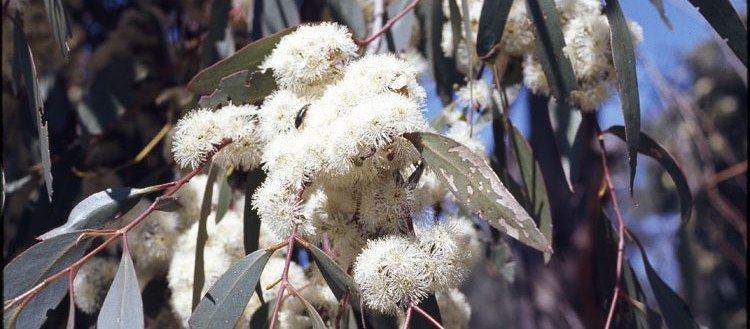Interactions
Photo: Ian Clark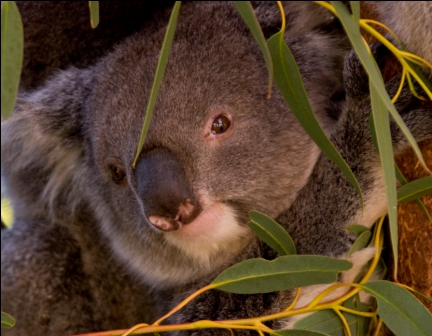
Eucalypts are at the center of many Australian ecosystems, and numerous organisms have lifestyles that include some type of interaction with these plants. The first organism that comes to mind for many is Phascolarctos cinereus, the koala, which feeds exclusively on eucalyptus leaves, preferring the leaves of the red, grey, manna, and swamp gums. However, many more complex webs of life are anchored to these trees.
As the eucalypts adapted to become
the dominant vegetation of the Australian bush and forest
landscapes, an open, spacious type of arboreal environment emerged.
This is an ideal place for the yellow-bellied glider,
Petauris australis, to
swoop from tree to tree, feeding on sap and dwelling in hollow
stumps. The trees are
primary producers, and their leaves provide
Nutrition to many herbivorous insects, which
in turn are an energy source for insectivores such as owls, bats,
and spiders. A common
parasite in these forests,
mistletoe, grows near the tops of the
trees and extends its roots into the tree’s branches and saps
nutrients.
Interestingly, the mistletoe is a favorite nursery for some species
of blue butterflies.
The leaves of eucalypts are rich
in oil, with E. dives
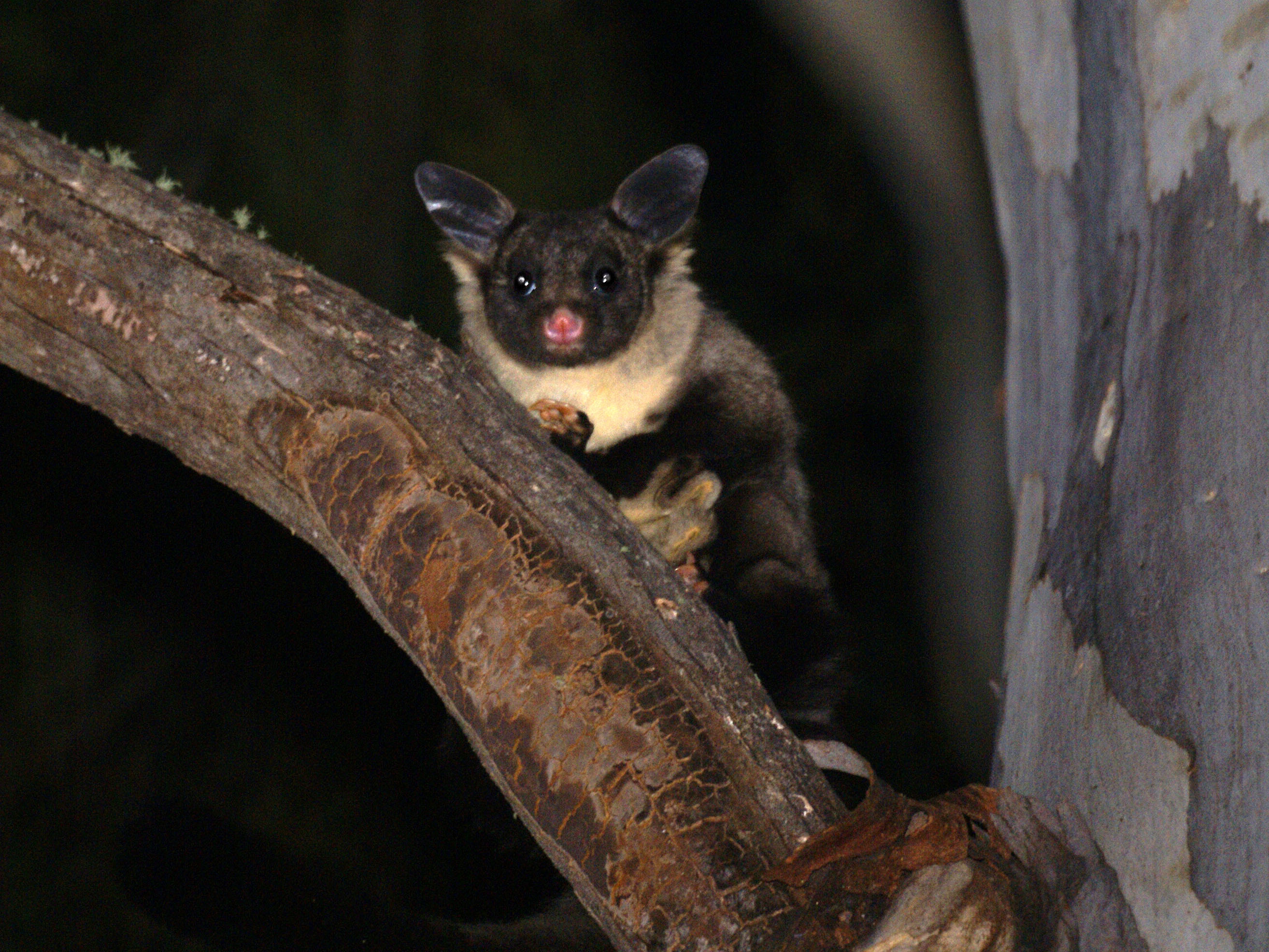 being
one that is commercially exploited, and within these oils
are special toxins designed to reduce predation.
However, certain herbivorous mammals, like the koala and the
common brushtail possum
Trichosurus vulpecula, have livers adapted to protect them from
these toxins.
being
one that is commercially exploited, and within these oils
are special toxins designed to reduce predation.
However, certain herbivorous mammals, like the koala and the
common brushtail possum
Trichosurus vulpecula, have livers adapted to protect them from
these toxins.
Photo (left): David Cook Wildlife Photography
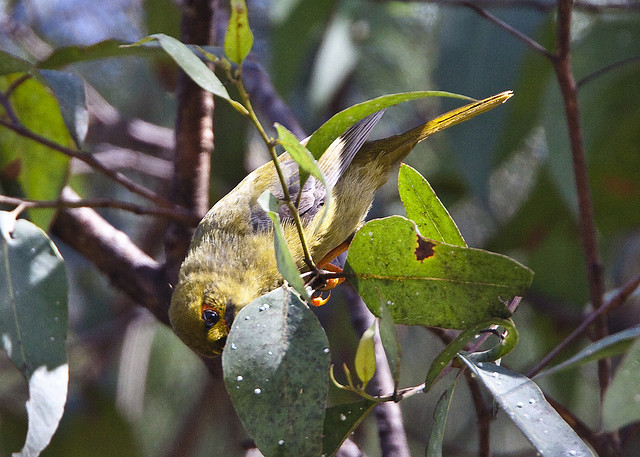
Some species of insects
lay eggs on the eucalyptus leaves, and when the insect larvae hatch
and begin feeding on the leaves, they form protective body casings
called lerps. These
lerps are composed of leaf material that the larvae could not
digest, and bell miner birds (Manorina
melanophrys) find them irresistible.
Groups of bell miners have even been seen vigorously
defending lerp territory.
Photo: Michael Dawes
Eucalyptus as a genus has enormous economic and physiological
significance to humans.
The fast-growing trees, particularly the giant
E. regnans, have been an
important source of timber for over a century in Australia.
Eucalyptus diversicolor was
especially prized as a ship-building hardwood because it has a
natural resistance to termites and teredo, or “shipworms” (a species
of clam). The timber
trees are also a renewable source of firewood, and the flowering
E. globulus is a preferred foraging tree for bees.
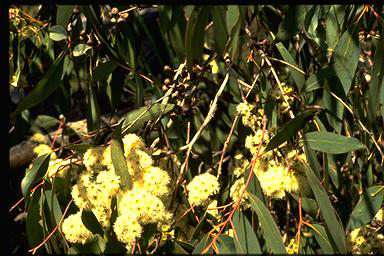 In addition, eucalyptus leaves are
a source of eucalyptus oil, with
E. dives being a tree
commercially cultivated for this product.
The relative chemical compositions of the oils vary by
species, but E. dives is
rich in a compound called eucalyptol (or cineole).
This biological compound has numerous medicinal properties.
It can be used as an anesthetic and
antitussive, making it a
good ingredient for cough drops, and as a decongestant and
expectorant, eucalyptol may appear in many over-the-counter cold
medicines. Some
mouthwash formulas list eucalyptol as an ingredient because, as an
antihalitosic, it fights bad breath.
Interestingly, eucalyptol has also been used as an antiseptic
(a chemical that prevents microbial growth), as an antihelmintic
(used in treating parasitic worms), and as a hypotensive agent (for
lowering blood pressure).
The aboriginal peoples native to Australia have also used the
leaves from the broad-leaf peppermint to make a tea to treat fevers.
The oil from E. dives
also contains a-terpineol, an aromatic alcohol, making it
popular on the fragrant essential oil market.
In addition, eucalyptus leaves are
a source of eucalyptus oil, with
E. dives being a tree
commercially cultivated for this product.
The relative chemical compositions of the oils vary by
species, but E. dives is
rich in a compound called eucalyptol (or cineole).
This biological compound has numerous medicinal properties.
It can be used as an anesthetic and
antitussive, making it a
good ingredient for cough drops, and as a decongestant and
expectorant, eucalyptol may appear in many over-the-counter cold
medicines. Some
mouthwash formulas list eucalyptol as an ingredient because, as an
antihalitosic, it fights bad breath.
Interestingly, eucalyptol has also been used as an antiseptic
(a chemical that prevents microbial growth), as an antihelmintic
(used in treating parasitic worms), and as a hypotensive agent (for
lowering blood pressure).
The aboriginal peoples native to Australia have also used the
leaves from the broad-leaf peppermint to make a tea to treat fevers.
The oil from E. dives
also contains a-terpineol, an aromatic alcohol, making it
popular on the fragrant essential oil market.
